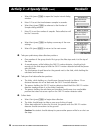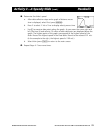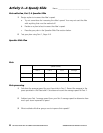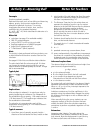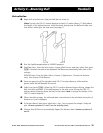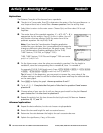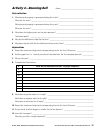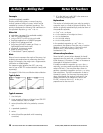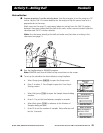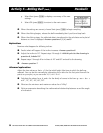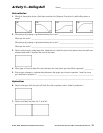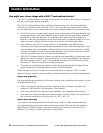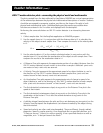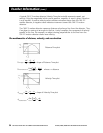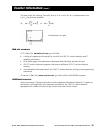
28 GETTING STARTED WITH THE CBR 2™ SONIC MOTION DETECTOR © 1997, 2004, 2006 TEXAS INSTRUMENTS INCORPORATED
Activity 5—Rolling Ball Notes for Teachers
Concepts
Function explored: parabolic
Plotting a ball rolling down a ramp of varying
inclines creates a family of curves, which can be
modeled by a series of quadratic equations. This
activity investigates the values of the coefficients in
the quadratic equation, y = ax
2
+ bx + c.
Materials
Ÿ calculator (see page 2 for available models)
Ÿ CBR 2™ motion detector
Ÿ unit-to-CBR 2™ or I/O unit-to-unit cable
Ÿ EasyData application or RANGER program
Ÿ large (9 inch) playground ball
Ÿ long ramp (at least 2 meters or 6 feet—a
lightweight board works well)
Ÿ protractor to measure angles
Ÿ books to prop up ramp
Ÿ TI ViewScreené panel (optional)
Hints
Discuss how to measure the angle of the ramp. Let
students get creative here in measuring the initial
angle. For example, they might use a trigonometric
calculation or folded paper.
For steeper angles (greater than 60º), you may
want to use a CBR 2™ motion detector clamp (sold
separately).
See pages 6–9 for hints on effective data collection.
Typical plots
15¡ 30¡
Typical answers
1. the third plot
2. time; seconds; distance of object from CBR 2™
motion detector; feet or meters
3. varies (should be half of a parabola, concave
up)
4. a parabola (quadratic)
5. varies
6. varies (should be parabolic with increasing
curvature)
7. 0¡ is flat (ball can’t roll); 90¡ is the same as a
free-falling (dropping) ball
Explorations
The motion of a body acted upon only by gravity is
a popular topic in a study of physical sciences. Such
motion is typically expressed by a particular form of
the quadratic equation,
s = ½at
2
+ v
i
t + s
i
where
0 s is the position of an object at time t
0 a is its acceleration
0 v
i
is its initial velocity
0 s
i
is its initial position
In the quadratic equation y = ax
2
+ bx + c,
y represents the distance from the
CBR 2™ motion
detector to the ball at time x if the ball’s initial
position was c, initial velocity was b, and
acceleration is 2a.
Advanced explorations:
Since the ball is at rest when released, b should
approach zero for each trial. c should approach the
initial distance, 0.5 meters (1.5 feet). a increases as
the angle of inclination increases.
If students model the equation y = ax
2
+ bx + c
manually, you may need to provide hints for the
values of b and c. You may also direct them to
perform a quadratic regression on lists
L1, L2 using
their calculators. The ball’s acceleration is due to
the earth’s gravity. So the more the ramp points
down (the greater the angle of inclination), the
greater the value of a. Maximum a occurs for
q = 90¡, minimum for q = 0¡. In fact, a is
proportional to the sine of q.



